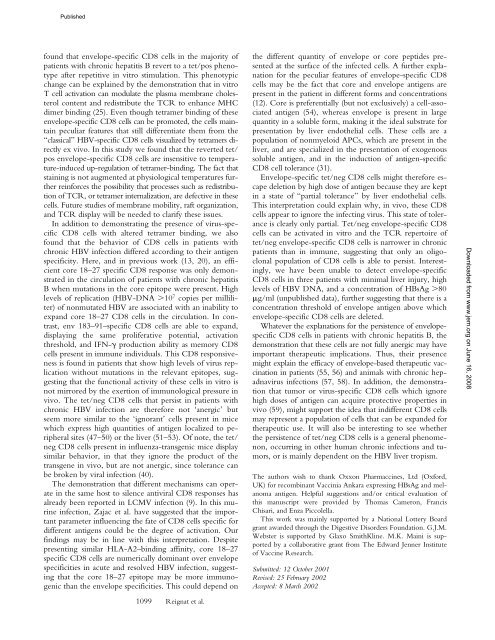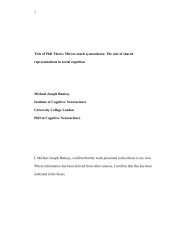Escaping High Viral Load Exhaustion: CD8 Cells with Altered ...
Escaping High Viral Load Exhaustion: CD8 Cells with Altered ...
Escaping High Viral Load Exhaustion: CD8 Cells with Altered ...
Create successful ePaper yourself
Turn your PDF publications into a flip-book with our unique Google optimized e-Paper software.
Published<br />
found that envelope-specific <strong>CD8</strong> cells in the majority of<br />
patients <strong>with</strong> chronic hepatitis B revert to a tet/pos phenotype<br />
after repetitive in vitro stimulation. This phenotypic<br />
change can be explained by the demonstration that in vitro<br />
T cell activation can modulate the plasma membrane cholesterol<br />
content and redistribute the TCR to enhance MHC<br />
dimer binding (25). Even though tetramer binding of these<br />
envelope-specific <strong>CD8</strong> cells can be promoted, the cells maintain<br />
peculiar features that still differentiate them from the<br />
“classical” HBV-specific <strong>CD8</strong> cells visualized by tetramers directly<br />
ex vivo. In this study we found that the reverted tet/<br />
pos envelope-specific <strong>CD8</strong> cells are insensitive to temperature-induced<br />
up-regulation of tetramer-binding. The fact that<br />
staining is not augmented at physiological temperatures further<br />
reinforces the possibility that processes such as redistribution<br />
of TCR, or tetramer internalization, are defective in these<br />
cells. Future studies of membrane mobility, raft organization,<br />
and TCR display will be needed to clarify these issues.<br />
In addition to demonstrating the presence of virus-specific<br />
<strong>CD8</strong> cells <strong>with</strong> altered tetramer binding, we also<br />
found that the behavior of <strong>CD8</strong> cells in patients <strong>with</strong><br />
chronic HBV infection differed according to their antigen<br />
specificity. Here, and in previous work (13, 20), an efficient<br />
core 18–27 specific <strong>CD8</strong> response was only demonstrated<br />
in the circulation of patients <strong>with</strong> chronic hepatitis<br />
B when mutations in the core epitope were present. <strong>High</strong><br />
levels of replication (HBV-DNA 10 7 copies per milliliter)<br />
of nonmutated HBV are associated <strong>with</strong> an inability to<br />
expand core 18–27 <strong>CD8</strong> cells in the circulation. In contrast,<br />
env 183–91–specific <strong>CD8</strong> cells are able to expand,<br />
displaying the same proliferative potential, activation<br />
threshold, and IFN- production ability as memory <strong>CD8</strong><br />
cells present in immune individuals. This <strong>CD8</strong> responsiveness<br />
is found in patients that show high levels of virus replication<br />
<strong>with</strong>out mutations in the relevant epitopes, suggesting<br />
that the functional activity of these cells in vitro is<br />
not mirrored by the exertion of immunological pressure in<br />
vivo. The tet/neg <strong>CD8</strong> cells that persist in patients <strong>with</strong><br />
chronic HBV infection are therefore not ‘anergic’ but<br />
seem more similar to the ‘ignorant’ cells present in mice<br />
which express high quantities of antigen localized to peripheral<br />
sites (47–50) or the liver (51–53). Of note, the tet/<br />
neg <strong>CD8</strong> cells present in influenza-transgenic mice display<br />
similar behavior, in that they ignore the product of the<br />
transgene in vivo, but are not anergic, since tolerance can<br />
be broken by viral infection (40).<br />
The demonstration that different mechanisms can operate<br />
in the same host to silence antiviral <strong>CD8</strong> responses has<br />
already been reported in LCMV infection (9). In this murine<br />
infection, Zajac et al. have suggested that the important<br />
parameter influencing the fate of <strong>CD8</strong> cells specific for<br />
different antigens could be the degree of activation. Our<br />
findings may be in line <strong>with</strong> this interpretation. Despite<br />
presenting similar HLA-A2–binding affinity, core 18–27<br />
specific <strong>CD8</strong> cells are numerically dominant over envelope<br />
specificities in acute and resolved HBV infection, suggesting<br />
that the core 18–27 epitope may be more immunogenic<br />
than the envelope specificities. This could depend on<br />
1099 Reignat et al.<br />
the different quantity of envelope or core peptides presented<br />
at the surface of the infected cells. A further explanation<br />
for the peculiar features of envelope-specific <strong>CD8</strong><br />
cells may be the fact that core and envelope antigens are<br />
present in the patient in different forms and concentrations<br />
(12). Core is preferentially (but not exclusively) a cell-associated<br />
antigen (54), whereas envelope is present in large<br />
quantity in a soluble form, making it the ideal substrate for<br />
presentation by liver endothelial cells. These cells are a<br />
population of nonmyeloid APCs, which are present in the<br />
liver, and are specialized in the presentation of exogenous<br />
soluble antigen, and in the induction of antigen-specific<br />
<strong>CD8</strong> cell tolerance (31).<br />
Envelope-specific tet/neg <strong>CD8</strong> cells might therefore escape<br />
deletion by high dose of antigen because they are kept<br />
in a state of “partial tolerance” by liver endothelial cells.<br />
This interpretation could explain why, in vivo, these <strong>CD8</strong><br />
cells appear to ignore the infecting virus. This state of tolerance<br />
is clearly only partial. Tet/neg envelope-specific <strong>CD8</strong><br />
cells can be activated in vitro and the TCR repertoire of<br />
tet/neg envelope-specific <strong>CD8</strong> cells is narrower in chronic<br />
patients than in immune, suggesting that only an oligoclonal<br />
population of <strong>CD8</strong> cells is able to persist. Interestingly,<br />
we have been unable to detect envelope-specific<br />
<strong>CD8</strong> cells in three patients <strong>with</strong> minimal liver injury, high<br />
levels of HBV DNA, and a concentration of HBsAg 80<br />
g/ml (unpublished data), further suggesting that there is a<br />
concentration threshold of envelope antigen above which<br />
envelope-specific <strong>CD8</strong> cells are deleted.<br />
Whatever the explanations for the persistence of envelopespecific<br />
<strong>CD8</strong> cells in patients <strong>with</strong> chronic hepatitis B, the<br />
demonstration that these cells are not fully anergic may have<br />
important therapeutic implications. Thus, their presence<br />
might explain the efficacy of envelope-based therapeutic vaccination<br />
in patients (55, 56) and animals <strong>with</strong> chronic hepadnavirus<br />
infections (57, 58). In addition, the demonstration<br />
that tumor or virus-specific <strong>CD8</strong> cells which ignore<br />
high doses of antigen can acquire protective properties in<br />
vivo (59), might support the idea that indifferent <strong>CD8</strong> cells<br />
may represent a population of cells that can be expanded for<br />
therapeutic use. It will also be interesting to see whether<br />
the persistence of tet/neg <strong>CD8</strong> cells is a general phenomenon,<br />
occurring in other human chronic infections and tumors,<br />
or is mainly dependent on the HBV liver tropism.<br />
The authors wish to thank Oxxon Pharmaccines, Ltd (Oxford,<br />
UK) for recombinant Vaccinia Ankara expressing HBsAg and melanoma<br />
antigen. Helpful suggestions and/or critical evaluation of<br />
this manuscript were provided by Thomas Cameron, Francis<br />
Chisari, and Enza Piccolella.<br />
This work was mainly supported by a National Lottery Board<br />
grant awarded through the Digestive Disorders Foundation. G.J.M.<br />
Webster is supported by Glaxo SmithKline. M.K. Maini is supported<br />
by a collaborative grant from The Edward Jenner Institute<br />
of Vaccine Research.<br />
Submitted: 12 October 2001<br />
Revised: 25 February 2002<br />
Accepted: 8 March 2002<br />
Downloaded from www.jem.org on June 16, 2008
















